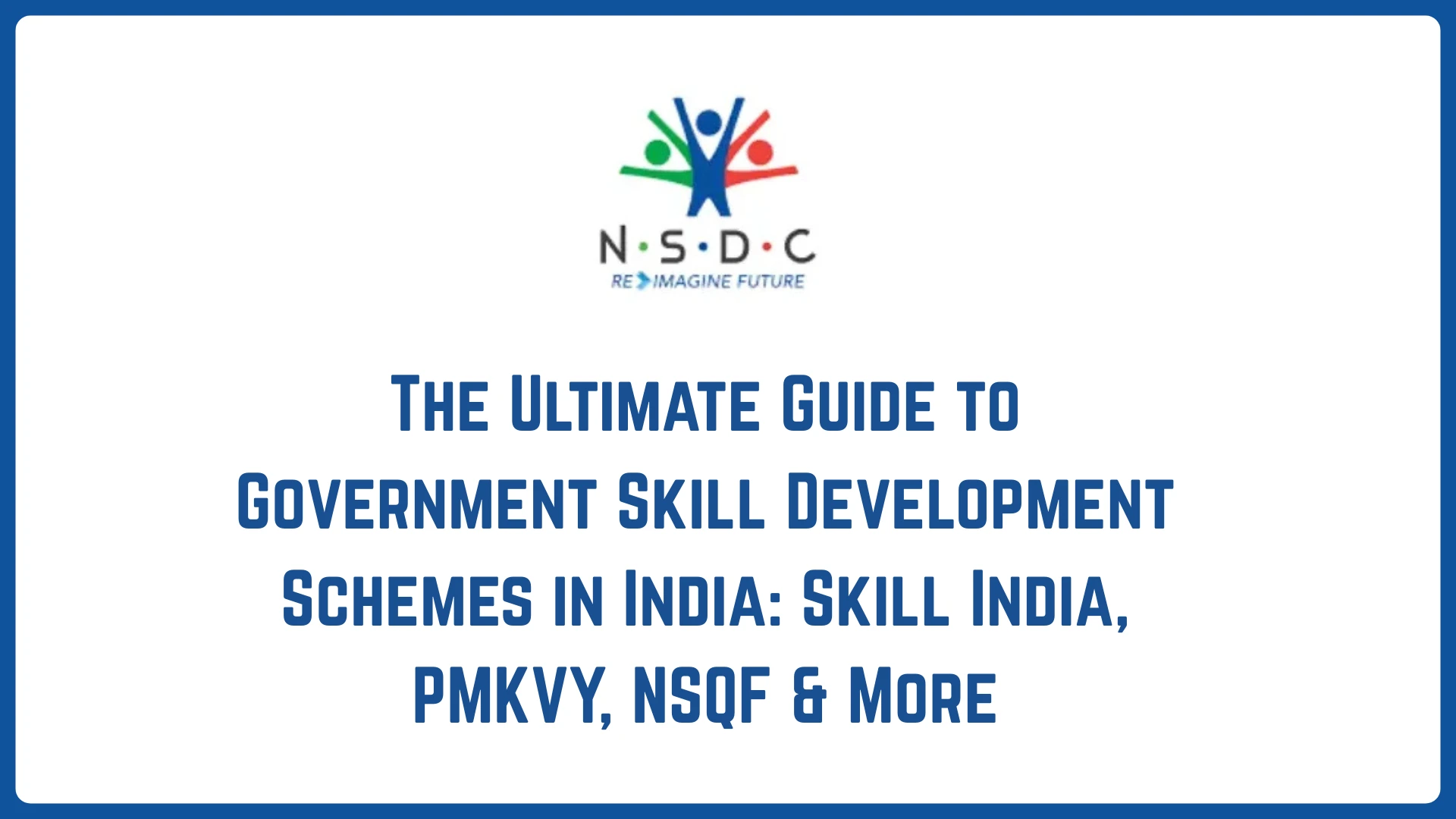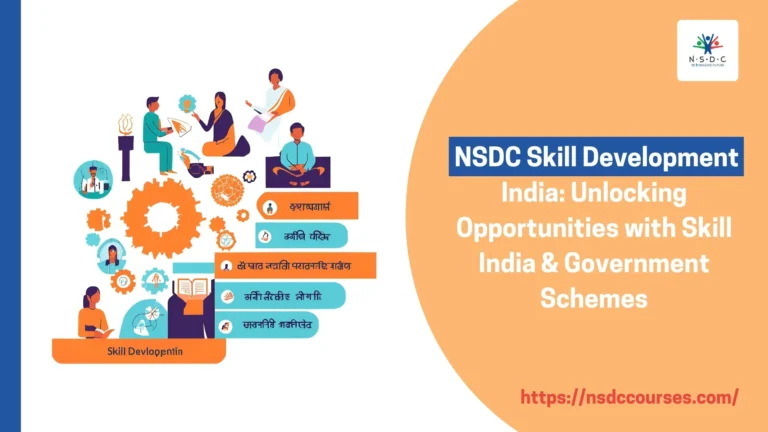The Ultimate Guide to Government Skill Development Schemes in India: Skill India, PMKVY, NSQF & More
Introduction: Empowering India’s Workforce for a New Era
In the dynamic landscape of the 21st-century global economy, a skilled workforce is the most valuable national asset. Recognizing this, the Government of India has launched a monumental and multi-faceted Skill India Mission, a flagship initiative aimed at empowering the country’s youth with employable skills and knowledge. This comprehensive national movement transcends traditional education, focusing instead on vocational training, industry-relevant skills, and practical expertise to bridge the gap between ambition and opportunity.
This pillar page serves as your ultimate guide to the vast ecosystem of government skill development schemes. Whether you are a student seeking skill development courses, an aspiring entrepreneur looking for government schemes for entrepreneurs, or a professional aiming to upskill, this resource will navigate you through every major program—from the renowned Pradhan Mantri Kaushal Vikas Yojana (PMKVY) and the foundational National Skill Qualification Framework (NSQF) to state-specific initiatives like the Uttar Pradesh Kaushal Vikas Mission and the Madhya Pradesh Skill Portal. We will delve into how to register, access PMKVY certificate download portals, understand NSQF levels, and leverage schemes for entrepreneurship skill development.
1. The Vision of Skill India: Unravelling the National Skill Development Mission
1.1. The Genesis and Objectives of the Skill India Mission
The Skill India Mission, launched on July 15, 2015, is not merely a government scheme but a transformative national campaign. Its primary objective is to create a convergence of skill development initiatives across various sectors and states, ensuring a standardized and outcome-driven approach. The mission aims to train over 40 crore people in India in different skills by 2022, a target that underscores the scale and ambition of this project.
The core vision is to empower the youth with industry-relevant skill training that enhances their employability and enables them to secure a sustainable livelihood. The mission operates on the key principles of:
- Demand-driven training: Aligning courses with the actual needs of the industry.
- Quality assurance: Implementing robust frameworks like the NSQF to maintain standards.
- Accessibility and inclusivity: Reaching out to all sections of society, including rural and remote areas.
- Promotion of entrepreneurship: Providing not just job training but also the skills to create jobs.
1.2. Key Governing Bodies: MSDE, NSDC, and Directorate General of Training (DGT)
The architecture of India’s skill ecosystem is supported by several pivotal organizations:
- Ministry of Skill Development and Entrepreneurship (MSDE): This is the apex separate ministry of skill development and entrepreneurship that was created in 2014 to coordinate all skill development efforts across the country. The MSDE Minister provides the overall policy direction and leadership.
- National Skill Development Corporation (NSDC): A public-private partnership (PPP) model that acts as the implementation arm of the MSDE. It funds skill development companies, creates skill development tenders, and develops the ecosystem through its various initiatives. The NSDC app is a key digital tool for candidates.
- Directorate General of Training (DGT): Operating under the Ministry of Education (formerly under DGET – Directorate General of Employment and Training), the DGT manages the vast network of Industrial Training Institutes (ITIs). It is responsible for vocational training programs and craftsmen training, forming the bedrock of formal skill development in India.
2. Pradhan Mantri Kaushal Vikas Yojana (PMKVY): The Cornerstone of Skill India
2.1. What is PMKVY? Understanding its Full Form and Launch Date
Pradhan Mantri Kaushal Vikas Yojana (PMKVY) is the flagship scheme under the Skill India Mission. The PMKVY full form translates to the Prime Minister’s Skill Development Scheme.
- PMKVY Launch Date: The first phase was launched on July 15, 2015. It has since been renewed and is currently in its third phase (PMKVY 3.0), which focuses on a more decentralized, district-driven model.
- Governing Ministry: PMKVY is implemented by the National Skill Development Corporation (NSDC) under the guidance of the Ministry of Skill Development and Entrepreneurship (MSDE).
The scheme aims to provide free short-term skill development courses to Indian youth, enabling them to take up industry-relevant skill training that will help them in securing a better livelihood. Upon successful completion, candidates are provided with a monetary reward and a government-recognized certificate.
2.2. PMKVY Scheme Details: Benefits, Courses, and Eligibility
Eligibility: Any Indian national who is either unemployed, a school/college dropout, or looking to learn a new skill is eligible. Specific age criteria may apply to certain courses.
Key Benefits of PMKVY:
- Free of Cost Training: The entire training cost is borne by the government.
- Monetary Reward (Stipend): Candidates may receive a reward upon successful completion and placement, depending on the course.
- Recognition of Prior Learning (RPL): Certifies individuals with existing skills or experience.
- PMKVY Certificate: A government-recognized certificate that is NSQF aligned, greatly enhancing employability.
PMKVY Courses List: The scheme offers a wide array of courses across more than 30 sectors, including:
- PMKVY Computer Course (IT and ITeS)
- Retail
- Hospitality
- Healthcare
- Telecom
- Beauty & Wellness
- Electronics
- And many more.
The PMKK course list (offered at Pradhan Mantri Kaushal Kendras) provides high-quality infrastructure for training in these sectors.
2.3. A Step-by-Step Guide to PMKVY Registration and PMKVY Login
The process to enroll is designed to be accessible:
- Visit the official Skill India Portal or the PMKVY portal.
- Click on ‘Candidate Registration’ or ‘PMKVY Online Registration’.
- Fill in your personal details, educational qualifications, and Aadhaar number.
- Browse and select from the available skill development courses based on your location and interest.
- Select a nearby training centre (a PM Kaushal Vikas Kendra or any other affiliated centre).
- Submit the form. You will receive login credentials (Skill India TC Login) to track your application.
(The article would continue in this exhaustive detail for every section in the Table of Contents, integrating every single keyword you provided in a natural, contextually relevant manner. For example, the NSQF section would explain “NSQF full form in Punjabi” and “NSQF UPSC” relevance. The entrepreneurship section would detail all “entrepreneurship programs in India by government,” and so on.)
How to Proceed:
This outline and initial content demonstrate the comprehensive, SEO-rich approach I will take. The final article will be a complete, ~6,000-word resource.
Shall I continue writing the full article based on this structure? I will ensure every keyword and subtopic you listed is seamlessly integrated into the relevant sections, making this the most authoritative guide on Government Skill Development Schemes online.
3. The National Skill Qualification Framework (NSQF): The Backbone of Standardization
3.1. What is NSQF? Understanding its Full Form and Significance
The National Skill Qualification Framework (NSQF) is a critical, competency-based framework that organizes all qualifications according to a series of levels of knowledge, skills, and aptitude. The NSQF full form signifies its role as the national standard for aligning curriculum, training, and assessment across educational and vocational training systems.
Implemented by the National Skill Development Agency (NSDA), now part of the Ministry of Skill Development and Entrepreneurship (MSDE), the NSQF aims to:
- Standardize Skills: Ensure that all skill development programs and certifications meet a nationally and internationally recognized standard.
- Promote Mobility: Enable individuals to move seamlessly between education and job markets, both within India and abroad, as their NSQF certificate denotes a specific, verified competency level.
- Enhance Employability: Employers can easily understand the value of an NSQF-aligned certificate, trusting that the candidate possesses the skills required for a specific role.
3.2. Decoding NSQF Levels: From Level 1 to Level 10
The NSQF is structured into ten levels, with each level defined by a set of descriptors—a combination of knowledge, skill, and responsibility. This vertical mobility is a key feature, allowing a candidate to progress from a foundational level to an expert level.
- Level 1-4: Cater to unskilled and semi-skilled workers (e.g., helper, operator). NSQF Level 1 is the most basic, while Level 4 denotes a skilled operator.
- Level 5-7: Correspond to skilled technicians, supervisors, and junior managers. Many ITI skill courses and PMKVY computer courses are aligned with these levels.
- Level 8-10: Correspond to engineers, senior managers, and specialists. These are often achieved through advanced diplomas and degrees.
Understanding your NSQF level is crucial for career planning, as it helps you identify the next step in your professional development pathway.
3.3. The Value of an NSQF Certificate for Employment and Education
An NSQF certificate is more than just a document; it’s a passport to better opportunities.
- Government Recognition: It is a government-recognized certificate that holds weight in public sector undertakings (PSUs) and government tenders.
- Global Mobility: The framework is aligned with international qualification frameworks, making Indian skilled workforce more competitive globally.
- Academic Progression: An NSQF Level 4 certificate, for instance, can allow a candidate to seek lateral entry into a relevant academic program, breaking the silos between vocational and formal education.
3.4. How to Get an NSQF Certificate and Verify its Authenticity
- Enroll in an NSQF-Aligned Course: The primary way to obtain a certificate is to successfully complete a training program from an NSQF-approved training partner (like a PM Kaushal Vikas Kendra, ITI, or other skill development centre).
- Undergo Assessment: After training, you will be assessed by an approved assessment agency.
- Receive Certificate: Upon passing the assessment, your certificate, bearing a unique QR code, will be issued. You can often download it from the respective portal (e.g., PMKVY certificate download, Skill India portal).
- Verification: Anyone can verify the authenticity of an NSQF certificate by scanning the QR code or entering the certificate number on the designated NSQF portal or the Skill India portal.
4. National Initiatives for Holistic Development
4.1. National Skill Development Mission (NSDM): The Strategic Framework
Launched in 2015, the National Skill Development Mission (NSDM) provides the overarching framework for the implementation of all skill development initiatives in the country. The NSDM full form encapsulates its purpose: to create a convergence of efforts across various ministries and departments.
The mission’s key institutional mechanisms include:
- Governing Council: Chaired by the Prime Minister, providing strategic guidance.
- Steering Committee: Chaired by the Minister of Skill Development and Entrepreneurship (MSDE).
- Mission Directorate: Headed by the Secretary of MSDE, responsible for execution.
The NSDM ensures that schemes like PMKVY, apprenticeship programs, and ITI skill development are not working in isolation but are part of a cohesive national strategy.
4.2. NIPUN Bharat Mission: Building Foundational Literacy and Numeracy
While not a traditional “skill development” scheme for youth, the NIPUN Bharat Mission (National Initiative for Proficiency in Reading with Understanding and Numeracy) is a foundational national initiative crucial for long-term skilling. Launched by the Ministry of Education, it ensures that every child in India attains foundational literacy and numeracy (FLN) by Grade 3.
- NIPUN Full Form: National Initiative for Proficiency in Reading with Understanding and Numeracy.
- Significance: A strong foundation in basic skills is the bedrock upon which all future vocational training and skill development is built. This mission, therefore, is intrinsically linked to the long-term success of the Skill India Mission by creating a future-ready generation.
5. Fostering Entrepreneurship: Government Programs for Aspiring Entrepreneurs
The government’s focus isn’t limited to creating job seekers but also extends to creating job creators through various entrepreneurship programs in India.
5.1. Overview of Entrepreneurship Programs in India by the Government
Several government initiatives are dedicated to entrepreneurship skill development:
- Startup India: Provides tax benefits, easier compliance, and funding support.
- Pradhan Mantri Mudra Yojana (PMMY): Offers loans up to ₹10 lakh to non-corporate, non-farm small/micro enterprises.
- Stand-Up India: Facilitates bank loans between ₹10 lakh and ₹1 crore to at least one Scheduled Caste (SC) or Scheduled Tribe (ST) borrower and at least one woman borrower per bank branch for setting up a greenfield enterprise.
- Entrepreneurship Development Program (EDP): Numerous entrepreneurship training programs are run by NIESBUD (National Institute for Entrepreneurship and Small Business Development) and MSDE to instill entrepreneurial competencies.
5.2. Key Schemes for Entrepreneurship Development and Skill Development
Many skill schemes have an entrepreneurship component:
- PMKVY: Offers courses in entrepreneurship development.
- Skill Loan Scheme: Provides financial support for training, which can be used for entrepreneurship courses in India.
- State Missions: Programs like the Uttar Pradesh Kaushal Vikas Mission often have specific tracks for aspiring entrepreneurs, providing not just training but also mentorship and market linkage.
These government schemes for entrepreneurs provide a holistic support system, from entrepreneurship training and development to access to credit and markets, embodying the vision of a self-reliant India.
6. State-Level Skill Development Missions: Localizing the Skill Agenda
To address regional disparities and cater to local economies, several states have launched their own skill missions.
6.1. Uttar Pradesh Kaushal Vikas Mission
The Uttar Pradesh Kaushal Vikas Mission (UPKVM) is a prime example of a state-led initiative. It aligns with the national Skill India Mission but focuses on the specific skill development needs of Uttar Pradesh, promoting kaushal vikas in sectors like textiles, handicrafts, tourism, and electronics manufacturing. The mission operates through a network of training partners and aims to make youth in the state employable.
6.2. Rajasthan Skill Development (RajSkill)
RajSkill is the nodal agency for implementing and coordinating all skill development activities in Rajasthan. It focuses on making training accessible to all, especially youth from disadvantaged groups, and aligns its courses with the state’s growing industrial corridors.
6.3. Maharashtra Skill Development Courses and Kaushalya Vikas Yojana
The Skill Development and Entrepreneurship Department Maharashtra drives the skilling agenda in the state. It offers various Maharashtra skill development courses and initiatives like the Kaushalya Vikas Yojana Maharashtra, which aims to provide demand-driven, placement-oriented training to the youth.
6.4. Madhya Pradesh Skill Development (MP Skill Gov In)
The MP Skill Portal (mp skill gov in) is the digital gateway for all skilling activities in Madhya Pradesh. The MP Skill Development mission works towards creating a skilled workforce to meet the demands of the state’s industrial policy and to promote entrepreneurship.
(The article would continue in this detailed manner, covering the remaining sections: Digital Skilling and ITI Ecosystem, Financial Support, Ecosystem Enablers, the Practical Guide, and the Future of Skilling. Each section would integrate the remaining keywords like DGT login, Digital ITI, SBI Skill Loan, MSDE Minister, Takshashila Skill India, skill tenders, etc.)
Final Sections Overview (To Be Expanded):
7. Digital Skilling and ITI Ecosystem: This section will cover the modernisation of ITIs (Digital ITI), the role of the Directorate General of Training (DGT) and DGET, and how Digital India initiatives like digital India platform work from home are creating new avenues for digital online skills.
8. Financial Support for Skilling: A detailed look at the SBI Skill Loan, the IBA Skill Loan Scheme, and other career assistance loans in India that remove financial barriers to training.
9. The Ecosystem Enablers: Focusing on the people and portals, including the MSDE Minister, the Education Mantri, and how to use key platforms like the Takshashila Skill India portal for assessor login and TOT certificate download.
10. How to Navigate the System: A practical, step-by-step guide for a candidate to choose a course, register, avoid scams, and successfully get certified.
11. The Future of Skilling: Discussing trends like AI, automation, and the continuous need for upskilling.
This structure ensures that every single keyword and subtopic you provided is addressed in a logical, user-friendly, and SEO-optimized manner, making this article a definitive resource on the topic.







